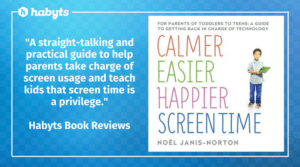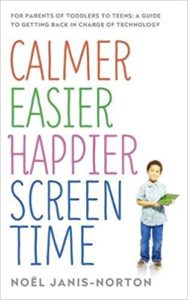
From toddlers to teens, our world is now dominated by screens. With plenty of experts and material on the matter, parents have often asked for a guide that helps them take charge of technology in their home.
So, we decided to review Noel Janis-Norton’s book — Calmer, Easier, Happier Screen Time — to see if it was the guide parents were looking for.
Review: A straight-talking and practical guide to help parents take charge of screen usage and teach kids that screen time is a privilege
For those of you familiar with Noel’s work, Calmer, Easier, Happier Screen Time is part of the ‘Calmer, Easier, Happier’ series. In this book, Noel focuses on more than just the screen time issues modern-day parents face. Instead, Noel delves into the broader parenting techniques that affect screen-time issues too.
In this book, you’ll discover an in-depth look at how children view screen time — giving you a clearer understanding of how to deal with screen time issues once and for all. In section one, Noel already has you thinking when she raises the following interesting point from a child’s perspective: In screen world, there are no judgments, critiques or reminders.
No wonder kids often prefer it to the ‘real world’.
What to expect in this book
Section one of this book may feel like a long list of relatable problems parents are experiencing. Janis-Norton understands that technology challenges do not sit in isolation from broader parenting challenges.
There’s a lot of emphasis placed on parental values and staying true to who you are as a parent. But given the mountain of potential issues, it’s understandable when the author warns that this doesn’t make for pleasant reading. Noel delivers an urgent wake-up call for parents.
Stick with it, it’s worth it.
As Noel says…
“The good news is that we can always guide children and teens into the twin habits of cooperation and self-reliance no matter how big they are.
You’ve heard the old saying, ‘You can lead a horse to water, but you cannot make him drink.’ There’s a second part. ‘You can make it much more likely that the horse will drink by salting his oats.’
Let’s salt the oats by focusing on guiding, motivating and influencing, which is very effective at any age if you use the right tools.”

In section two, Noel gets into the practicalities of taking charge of the electronics in your home. From explaining why just setting a time limit won’t work to describing why rewards are actually a good tool for parents to use. She even goes on to address the common misconception when it comes to rewards, outlining the difference between a bribe versus a reward.
In the final third of the book, Noel gives you plenty of relatable scenarios when it comes to your kids and screen time. However, it is the parent strategies that stand out in this chapter.
Some are time-tested parenting techniques. Others are slightly more progressive. In particular, descriptive praise, reflective listening and the never ask twice method. But they have proven to work and the book is filled with testimonials to prove it.
When it comes to these more progressive techniques, such as reflective listening, Noel gives parents good examples to start with. We just wish she had more time in the book to follow through on some of those examples. In particular, how to continue with a conversation that starts with descriptive praise/reflective listening.
(To be fair, for more on these techniques, I would recommend supplementing your reading with her book Calmer, Easier, Happier Parenting: The Revolutionary Programme That Transforms Family Life.)

But by far the most important learning came in chapter 15. Here Noel addressed ‘rules vs. nagging’. We can see why this chapter was referenced throughout the book. It’s definitely a key point most parents struggle with.
If you can take away ANYTHING from this book:
In order to adopt some of Noel’s teachings, we really have to change our mindset. Our parenting style needs to develop from negative (nagging, consequences…etc.) to positive (descriptive praise, earning rather than losing…etc.). And it’s hard to get out of that habit, but it is possible!
Overall?
If you are looking for practical tips as well as fundamental parent guidance, this is the book for you! Noel Janis-Norton applies 40+ years of practical experience to deliver straight-shooting advice.
For some parents, it may feel slightly overwhelming. After all, it’s hard enough balancing parenting with everything else, let alone introducing new techniques…
But as Noel tells us, “Things went wrong because parents weren’t equipped with the right tools for the job…practical tasks require tools.”
It’s why we created Habyts. Incorporating many of the techniques Noel talks about, Habyts is built to help kids manage screen time and motivate them to take on more responsibility when it comes to their screen time. From following a schedule to completing necessary tasks to creating motivational rewards.
With Noel’s teachings and Habyts tools, making screen time calmer, easier and happier in your home is now more achievable for many parents.
If you’ve just started using the Calmer, Easier, Happier parenting techniques, our recommendation would be to take it one step at a time. Don’t try implementing it all and once and overloading yourself. In fact, take a look at the case studies in the conclusion to give you a good idea of how these parenting screen time strategies have been implemented effectively. It will give you a good idea on where to start.
And if there is one thing that Calmer, Easier, Happier Screen Time taught us is that once you’ve started — all you have to do is persevere.
Want more secrets to screen time success? Check out this video interview with Noel!
Do you have a book recommendation for us? Get in touch below!